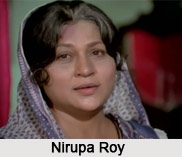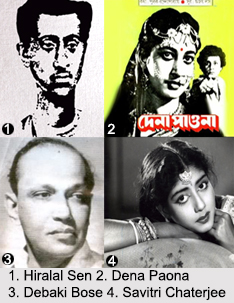 Nirupa Roy is an Indian movie actress who was renowned for her motherly appearance on screen many a times with different actors. She was the most notable screen mother in Indian cinema. Through some of her excellent performances she created new meaning and emotional intensity to the maternal image as well. She played leading roles in her early films and started playing mother roles during the 1970s and 1980s. Her acting career spanned more than 50 years, and she acted in more than 275 films. She was referred to as the "Queen of Misery" in Hindi film circles. She died, after having a cardiac arrest, in Mumbai on 13th October 2004 at the age of 73. She was regarded as the greatest `Mother` of all times in Bollywood.
Nirupa Roy is an Indian movie actress who was renowned for her motherly appearance on screen many a times with different actors. She was the most notable screen mother in Indian cinema. Through some of her excellent performances she created new meaning and emotional intensity to the maternal image as well. She played leading roles in her early films and started playing mother roles during the 1970s and 1980s. Her acting career spanned more than 50 years, and she acted in more than 275 films. She was referred to as the "Queen of Misery" in Hindi film circles. She died, after having a cardiac arrest, in Mumbai on 13th October 2004 at the age of 73. She was regarded as the greatest `Mother` of all times in Bollywood.
Personal Life of Nirupa Roy
Nirupa Roy was born as "Kokila Kishorechandra Bulsara" in Valsad, Gujarat. She was married to Kamal Roy when she was 15 and moved to Mumbai. They have two sons, Yogesh and Kiran. She changed her first name when she entered the film industry. She was Gujarati and taught children Gujarati language before she acted in films.
Film Career of Nirupa Roy
Nirupa Roy, came to Mumbai as a newly wed, and made her debut film as Nirupa Roy in the Gujarati film "Ranakdevi" in the year 1946. But it was the Gujarati-Hindi bilingual film "Gunsundari" in 1948, in which she played a housewife who wins back her husband. She was recognized for her expressive face, sonorous voice and intense eyes. Because of her all these qualities she played the roles of Hindu Goddesses like "Sita", "Parvati", "Lakshmi" and legendary figures such as "Mirabai" and "Savitri" in Indian cinema. In the year 1953 director Bimal Roy cast her as the wife of the veteran actor Balraj Sahni in "Do Bigha Zameen". She starred in several films with another well-known actor of the 1950s Bharat Bhushan. Some of the remarkable films of that pair were "Samrat Chandragupta", "Rani Rupmati" and "Kavi Kalidas". But, in the 1960s, new young actresses were emerging and Roy found it harder to be cast as the heroine. She began to appear in maternal roles, portraying the mother in "Chhaya" and "Mujhe Jeene Do".
She was recognized for her expressive face, sonorous voice and intense eyes. Because of her all these qualities she played the roles of Hindu Goddesses like "Sita", "Parvati", "Lakshmi" and legendary figures such as "Mirabai" and "Savitri" in Indian cinema. In the year 1953 director Bimal Roy cast her as the wife of the veteran actor Balraj Sahni in "Do Bigha Zameen". She starred in several films with another well-known actor of the 1950s Bharat Bhushan. Some of the remarkable films of that pair were "Samrat Chandragupta", "Rani Rupmati" and "Kavi Kalidas". But, in the 1960s, new young actresses were emerging and Roy found it harder to be cast as the heroine. She began to appear in maternal roles, portraying the mother in "Chhaya" and "Mujhe Jeene Do".
Nirupa Roy played her first mother in the year 1955. In that film she was the mother of Dev Anand and the film was "Munimji". At that time she was 24 and was seven years younger than her screen son. Almost two decades later, when she worked with the superstar Amitabh Bachchan, because of her intense acting skill many believed she was his real mother. She appeared in nearly 300 films, and acted the heroine in more than a hundred. In 1975 she played her most famous mother"s role in landmark movie "Deewar". In that film she was a woman caught between the conflicting values of her two sons. She again excelled as the blind mother in "Amar Akbar Anthony" in 1977. She played many roles as Amitabh Bachchan"s mother including "Muqaddar Ka Sikandar", "Mard" and "Ganga Jamuna Saraswati". During the 1980s and 1990s, she cut down her work drastically but again returned back as Bachchan"s mother for the last time in "Lal Badshah" in 1999. Apart from her work as an actor, she also had a remarkable singing career and released a number of albums of Indian music.
 Achievements of Nirupa Roy
Achievements of Nirupa Roy
Nirupa Roy was a splendid actress who has won awards in many of her films. Her success has been reflected in 3 awards from 1955 to 1964 for her role in "Munimji", "Chhaya" and "Shehnaai". In the year 1955 she was awarded "Filmfare Best Supporting Actress Award" for the film "Munimji", in 1961 she got "Filmfare Best Supporting Actress Award" in "Chhaya". In 1961 she won "BFJA Best Actress in Supporting Role" in "Chhaya". In the year 1964 she again won "Filmfare Best Supporting Actress Award" for "Shehnaai". She was awarded with "Filmfare Lifetime Achievement Award" in 2004.




















